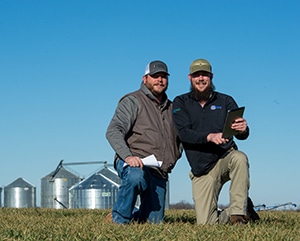Harris Farms is headquartered in Hepler, Kansas, and covers 5,000 acres in Bourbon and Crawford counties in the southeastern part of the state. Fourth-generation farmer Wyatt Harris has been improving the ground on every field since he started farming in 2007. A 40 percent corn and 60 percent soybean mix is fairly standard, although Harris mixes in wheat when market conditions are favorable.
In 2011, Harris partnered with AGChoice/MFA, Inc., to help reduce erosion and nutrient loss on high-yielding fields. Before then, he used a flat rate of N, P and K based on an average yield goal. When MFA launched its precision agronomy department, Harris moved to variable-rate technology to optimize fertilizer and seeding rates to reduce nutrient loss caused by soil erosion. He now samples his soil in 2.5-acre grids, testing nutrient levels, soil pH, cation exchange capacity and organic matter. He uses the results to formulate fertilizer application rates. A VRT applicator ensures it is applied at the right rate and right place.
“Most of the ground I’ve picked up through the years was on old fertility programs that left us with P1 and P2 levels in single digits,” Harris says. “Now, most of them are well into the teens, which is good for this area.”
Working with Shannon McClintock, staff agronomist with MFA, Harris started split-applying nitrogen for corn in 2017. He initially applies a flat rate of UAN 32 percent as a carrier for spring burndown, followed by a top-dressing of SuperU® to prevent denitrification, leaching and volatilization. Harris also implemented MFA’s VRT seed prescription which is based on multiple years of yield data. Yield goal management zones complement the variable-rate planting and are incorporated into the nitrogen model to ensure in-season nitrogen application is efficient.
The same year, Harris started nitrogen modeling that incorporates data from grid sampling, seeding rates, variable yield goals across each field, previous nitrogen applications, weather data and other factors that influence nitrogen loss or gain. His nitrogen use efficiency on corn was 1.1 unit/bu. Because of drought, his NUE in 2018 was 1.2 unit/bu, but he was able to apply 20 fewer units per acre compared to 2017. Always looking for improvement, Harris switched from conventional tillage to 100 percent no-till in 2018 to improve soil health and erosion control. He also introduced cover crops that year. It paid off. A hot, dry summer in 2020 made for a poor corn crop, but Harris increased his wheat acres to use the leftover nitrogen.
“Wyatt has been accepting of these changes and unlike some farmers who’ll try a practice on a few hundred acres, Wyatt has the mentality that if something is the right thing to do and is going to be best for his farm, he’ll do it on the entire farm,” McClintock says.
The 4Rs are working. Harris says corn yields are up 10 percent, soybean yields are up five to 10 percent and fertilizer use continues to decline.
Best Practice Management
- Use of urease inhibitor to reduce nitrogen loss
- Grid soil sampling every four years
- Split-applying nitrogen for increased efficiency in wheat and corn
- Variable-rate seed planning
- Variable-rate nutrient application across the farm
- Cover crops
- No-till
